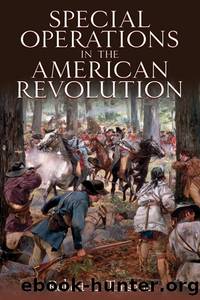Special Operations in the American Revolution by Robert L. Tonsetic

Author:Robert L. Tonsetic [Tonsetic, Robert L.]
Language: eng
Format: epub
Tags: History, United States, Revolutionary Period (1775-1800)
ISBN: 9781612001654
Google: rZHUAgAAQBAJ
Publisher: Casemate
Published: 2013-07-19T04:10:33+00:00
After the American victories at Trenton on December 26, 1776, and Princeton on January 3, 1777, Washingtonâs army went into winter quarters in the hills around Morristown in northern New Jersey. General Howe then decided to withdraw from his outposts in southern and central New Jersey, and occupy only a strip of land in northeast New Jersey running from New Brunswick to Perth Amboy. Howe did not plan for a winter campaign in New Jersey, but remained concerned that Washingtonâs army was encamped just 30 miles from New York City.
After the battle of Princeton, General Washington formulated a strategy for the winter of 1777. Washingtonâs plans did not include an attack on British-occupied New York City during the winter months, but he was determined not to give the British army any rest. He therefore planned a campaign of harassment and interdiction using small detachments of Continentals and militia. Those forces would attack British outposts, supply depots, and intercept British foraging parties as they searched the countryside for forage for their horses and other plunder. Washington knew that General Howe could not feed his troops and their horses solely from foodstuffs and forage shipped from Britain, and was reliant on his men foraging in the countryside. Washington knew that if British foraging parties were attacked, the British would have to send escort forces with them, of up to two thousand men in strength.13 Washington also ordered the Continentals and militia to clear horses, wagons, and other livestock from all areas near the British lines to prevent their confiscation and use by the British in a spring campaign. Thus, Washingtonâs winter campaign was essentially a âforage war.â
Inspired by Washingtonâs successes at Trenton and Princeton, Patriot militiamen, who felt powerless after Washingtonâs army withdrew to Pennsylvania, were eager to take the offensive against the British and their Loyalist allies. Washington knew that his Continentals were not capable of impeding all British efforts to gather supplies from the countryside, and the success of his winter war depended in large measure on the militias.
New Jersey militia units and local partisans played a major role in the winter war of 1777, at times operating on their own, and when necessary supported by detachments of Continentals. In late January 1777, Colonel Philemon Dickinson led four hundred New Jersey militia in a an attack on a British foraging party near Somerset Court House in north central New Jersey. The militia captured 40 wagons filled with forage and other foodstuffs, along with one hundred horses, and several prisoners. Dickinson would later become the overall commander of the New Jersey militia. On February 1, some five hundred Continental light infantry and four hundred New Jersey militia, under the overall command of Colonel Charles Scott, attacked a two-thousand-man British foraging party near New Brunswick in Middlesex County. After the heavy fighting, the British withdrew, leaving behind a number of wagonloads of hay. It was a costly defeat for the British, who sustained around one hundred casualties, while the American losses totaled 24 killed and wounded.
Download
This site does not store any files on its server. We only index and link to content provided by other sites. Please contact the content providers to delete copyright contents if any and email us, we'll remove relevant links or contents immediately.
| Americas | African Americans |
| Civil War | Colonial Period |
| Immigrants | Revolution & Founding |
| State & Local |
In Cold Blood by Truman Capote(3311)
The Innovators: How a Group of Hackers, Geniuses, and Geeks Created the Digital Revolution by Walter Isaacson(2845)
Steve Jobs by Walter Isaacson(2836)
All the President's Men by Carl Bernstein & Bob Woodward(2328)
Lonely Planet New York City by Lonely Planet(2172)
And the Band Played On by Randy Shilts(2130)
The Room Where It Happened by John Bolton;(2104)
The Poisoner's Handbook by Deborah Blum(2093)
The Murder of Marilyn Monroe by Jay Margolis(2059)
The Innovators by Walter Isaacson(2056)
Lincoln by David Herbert Donald(1945)
A Colony in a Nation by Chris Hayes(1881)
Under the Banner of Heaven: A Story of Violent Faith by Jon Krakauer(1750)
Amelia Earhart by Doris L. Rich(1650)
The Unsettlers by Mark Sundeen(1647)
Being George Washington by Beck Glenn(1622)
Birdmen by Lawrence Goldstone(1621)
Dirt by Bill Buford(1612)
Zeitoun by Dave Eggers(1593)
